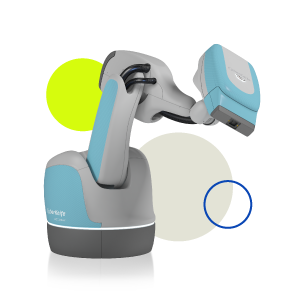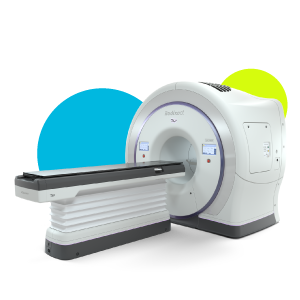Clinical teams around the globe are using the CyberKnife® Treatment Delivery System to open up new possibilities in ultra-hypofractionated radiation therapy for prostate cancer patients. Research has already shown that using the CyberKnife System to deliver ultra-hypofractionated stereotactic body radiation therapy (SBRT) can achieve excellent cancer control — with survival rates, toxicity and incidences of side effects equal to, or better than, conventional fractionation or moderately hypofractionation — in dramatically fewer treatment sessions.
2-year evidence supports what we’ve seen and heard from clinics around the world: Ultra-hypofractionated SBRT is an effective and less disruptive alternative to conventional fractionation or moderately hypofractioned SBRT — and the CyberKnife System can provide real-time adaptive delivery, demonstrating a better option for delivering ultra-hypofractionated SBRT, compared to a conventional linac.
About the PACE-B study
The PACE-B study is a Phase III, multi-institutional study, comprising 35 centers in the UK, Ireland, and Canada. In the study, 847 patients were split into conventional fractionation or moderately hypofractionated radiation therapy (78 Gy in 39 fractions or 60 Gy in 20 fractions or) and ultra-hypofractionated SBRT (36.25-40 Gy in 5 fractions). Going further, the study split the SBRT cohort between CyberKnife SBRT (169 patients) and conventional linac SBRT (245 patients).
SBRT with minimized toxicity
The PACE-B study provides strong clinical evidence that CyberKnife SBRT can minimize side effects, compared to SBRT with a conventional linac. The CyberKnife System SBRT cohort demonstrated approximately 50% lower grade 2 and higher genitourinary toxicity at 2 years compared to conventional linac SBRT; resulting in a significant difference between the two cohorts. Patients treated with SBRT on the CyberKnife System also had fewer grade 2 and higher gastrointestinal toxicities compared to conventional linac. These reductions in toxicities allow patients to experience less disruption to their lives, whilst maintaining excellent outcomes1.
Enabling precise ultra-hypofractionation
Clinical evidence is showing that ultra-hypofractionation is becoming a popular choice in prostate cancer patients with the CyberKnife System consistently demonstrating excellent outcomes. A study with 10 years of clinical evidence evaluating 259 low-intermediate prostate cancer patients receiving just four SBRT fractions with the CyberKnife System demonstrated excellent clinical outcomes. The results indicated 100% ten-year biochemical-free recurrence for low-risk patients and 84.3% biochemical-free recurrence for intermediate-unfavourable prostate cancer patients. The SBRT dose fractionation was designed to be identical to that of High Dose Rate (HDR) brachytherapy but with the obvious advantage of CyberKnife being non-invasive and potentially more widely available. They concluded that this HDR-like SBRT regime with the CyberKnife System was effective in delivering high intraprostatic doses on a daily basis2.

Effective and less disruptive than conventional fractionation
Further clinical evidence published in 2018 also demonstrated that SBRT on the CyberKnife System provides a highly effective alternative to conventional fractionation. In the 2018 study, 97% of patients experienced excellent cancer control at five years post SBRT with almost identical results for low- and intermediate-risk patients, compared to conventional fractionation. Toxicity and side effects were uncommon and similar to IMRT and other conventional radiation therapy3.
CyberKnife System revolutionizing ultra-hypofractioned SBRT and enhancing patient outcomes
This growing clinical evidence supports what clinicians using the CyberKnife System have been reporting for the last decade: The combination of sub-millimeter robotic accuracy and Synchrony® real-time motion tracking with dynamic delivery enable clinical teams to target the cancer and minimize dose to healthy and sensitive tissues. This gives clinical teams the confidence they need to deliver ultra-hypofractionated SBRT treatments in five or fewer treatments — compared to 20-39 treatments with moderate hypofractionation or conventional fractionation.
Together, these unmatched CyberKnife System capabilities give prostate cancer patients a truly revolutionary treatment option: A fully outpatient treatment option, which requires no general anesthesia and no hospitalization, that can achieve excellent cancer control in fewer treatment sessions and with lower risk of side effects.
Visit the 30 years of evidence page to see a selection of research on the CyberKnife System
References:
- Tree et al (2022) ‘Intensity-Modulated Fractionated Radiotherapy Versus Stereotactic Body Radiotherapy for Prostate Cancer (PACE-B): 2-year Toxicity Results From an Open-label, Randomised, Phase III, Non-inferiority Trial’ Lancet Oncol https://doi.org/10.1016/S1470-2045(22)00517-4
- Fuller D.B. et al (2022) ‘High Dose “HDR-Like” Prostate SBRT: PSA 10-Year Results From a Mature, Multi-Institutional ClinicalTrial’ Front Oncol. 12:935310
- Meier, RM et al (2018) MulticenterTrial of Stereotactic Body Radiation Therapy for Low- and Intermediate-Risk Prostate Cancer: Survival and Toxicity Endpoints. IntJ Radiat Oncol Biol Phys 102(2):296-303









